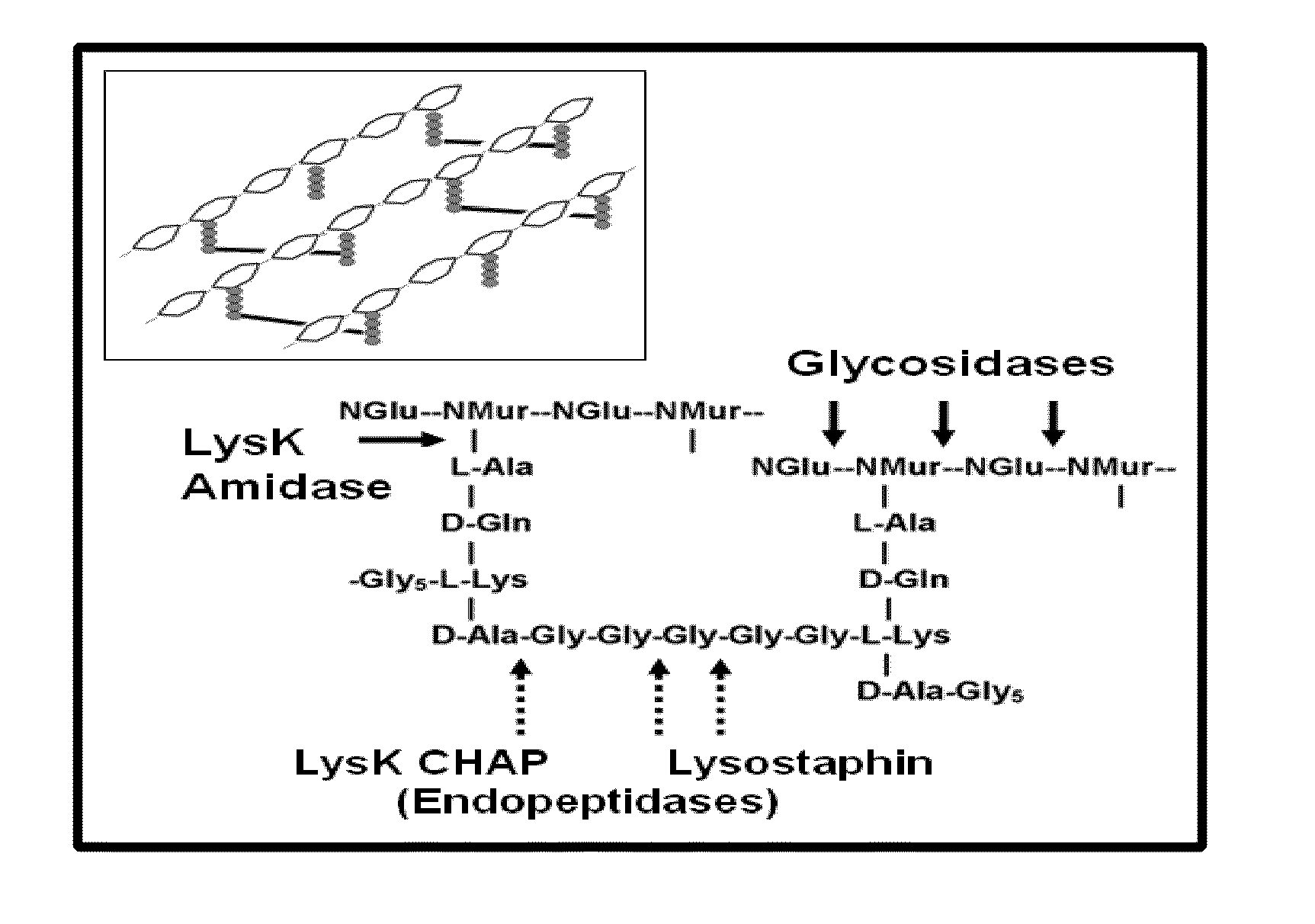Fusion of Peptidoglycan Hydrolase Enzymes to a Protein Transduction Domain Allows Eradication of both Extracellular and Intracellular Gram Positive Pathogens
a technology of peptidoglycan hydrolase and protein, which is applied in the direction of enzyme stabilisation, peptide/protein ingredients, antibacterial agents, etc., can solve the problems of high frequency of treatment failure, inability to effectively treat s. aureus, and deep-seated intramammary abscesses, so as to facilitate the translocation of full-length proteins and effective antimicrobial treatment
- Summary
- Abstract
- Description
- Claims
- Application Information
AI Technical Summary
Benefits of technology
Problems solved by technology
Method used
Image
Examples
example 1
Plasmids, Constructs and Strains
[0077]All subcloning was performed in E. coli DH5α (Invitrogen, Carlsbad, Calif.) for plasmid DNA isolation and sequence verification of all constructs. pET21a constructs were induced in E. coli BL21(DE3) (EMD Biosciences, San Diego, Calif.). Staphylococcus aureus Newbolt 305 capsular polysaccharide serotype 5 (ATCC 29740), S. aureus UAMS-1 (ATCC 49230), S. aureus strain Newman, and the MRSA strains: NRS194, NRS 271, and NRS 384 were grown at 3TC in Brain Heart Infusion broth (BD, Sparks, Md.) or Tryptic Soy Broth (BD, Sparks, Md.).
example 2
[0078]PCR cloning was used to create the Lyso-PTD construct. The reverse PCR primer Lyso-TAT-XhoR (5′-GTG GTG CTC GAG GCG GCG GCG CTG GCG GCG TTT TTT GCG CTT TAT AGT TCC-3′ (SEQ ID NO: 5) containing sequences encoding a 9 amino acid derivative (italics) of the 13 amino acid HIV-TAT PTD sequence (Table I), the last four codons (bold) of the C-terminus of the lysostaphin gene and an engineered XhoI site (underlined), together with a generic pET21a forward primer harboring an NdeI site at the translational start site, were used to amplify just the mature lysostaphin (256 aa) in a pET21a derived vector. The amplified Lyso-PTD DNA fragment was restriction enzyme digested (XhoI and NdeI) and ligated into similarly digested pET21a using conventional molecular techniques. BL21(DE3) E. coli (EMD Biosciences, San Diego, Calif.) were transformed with the characterized ligated coding sequences (SEQ ID NO:1) and the expressed protein products were purified (SEQ ID NO:2).
example 3
Extract Preparation and Protein Purification
[0079]E. coli BL21(DE3) cells harboring plasmid constructs were grown in 500 ml Superbroth (Becton Dickenson, Franklin Lakes, N.J.) supplemented with 100 ug / ml ampicillin at 37° C. with shaking. At mid log phase (OD600nm of 0.4-0.6), cultures were induced with 1 mM IPTG (isopropyl-beta-D-thiogalactopyranoside) followed by four hours shaking at 37° C. Cells were pelleted, washed with lysis buffer (50 mM NaH2PO4, 300 mM NaCl, 10 mM Imidazole, pH 8) and pellets frozen at −80° C. Extracts were prepared according to a modified procedure of Pritchard et al. (2004. Microbiology 150: 2079-2087). For nickel column-purified protein, cell pellets from 500 ml cultures were resuspended in 10 ml lysis buffer (50 mM NaH2PO4, 300 mM NaCl, 10 mM Imidazole, pH 8) and disrupted with 15×10 second pulses of sonication on ice with 10 second rest periods between pulses. Lysates were centrifuged at 6800 rpm in a Sorvall HS4 rotor (8500×g) and the supernatant deca...
PUM
| Property | Measurement | Unit |
|---|---|---|
| MW | aaaaa | aaaaa |
| pH | aaaaa | aaaaa |
| Tm | aaaaa | aaaaa |
Abstract
Description
Claims
Application Information
 Login to View More
Login to View More - R&D
- Intellectual Property
- Life Sciences
- Materials
- Tech Scout
- Unparalleled Data Quality
- Higher Quality Content
- 60% Fewer Hallucinations
Browse by: Latest US Patents, China's latest patents, Technical Efficacy Thesaurus, Application Domain, Technology Topic, Popular Technical Reports.
© 2025 PatSnap. All rights reserved.Legal|Privacy policy|Modern Slavery Act Transparency Statement|Sitemap|About US| Contact US: help@patsnap.com



